
JOURNAL OF FOOD AND DRUG ANALYSIS
Scope & Guideline
Connecting Science to Society through Food and Drug Research
Introduction
Aims and Scopes
- Food Safety and Quality Control:
The journal emphasizes the detection and analysis of food contaminants, nutritional components, and bioactive substances to ensure food safety and quality. - Pharmacological Analysis of Natural Products:
It explores the pharmacological properties of natural compounds, with a focus on traditional medicine and their applications in modern therapeutics. - Advanced Analytical Techniques:
The journal showcases novel analytical methodologies, including mass spectrometry, chromatography, and nanotechnology, for the detection and quantification of substances in food and drugs. - Interdisciplinary Research:
The journal promotes interdisciplinary studies that combine food science, pharmacology, biochemistry, and material science to address complex health-related issues. - Nanotechnology Applications:
There is a strong focus on the application of nanomaterials in food and drug analysis, particularly in enhancing detection methods and therapeutic delivery systems.
Trending and Emerging
- Nanomaterials in Analysis:
The use of nanomaterials, such as gold nanoparticles and carbon dots, is on the rise for their application in advanced sensing and detection methods, showcasing their potential in enhancing analytical sensitivity. - Functional Foods and Bioactive Compounds:
There is an increasing focus on the health benefits of functional foods, exploring their bioactive compounds and potential therapeutic effects, particularly in relation to chronic diseases. - AI and Machine Learning in Food Safety:
The integration of artificial intelligence and machine learning techniques in food safety management and drug analysis is emerging as a significant trend, improving predictive capabilities and efficiency. - Natural Preservatives and Green Chemistry:
Research on natural preservatives and eco-friendly extraction methods is gaining traction, reflecting a broader trend towards sustainability and health-conscious consumer preferences. - Microbiome and Health:
Studies investigating the relationship between food components, gut microbiota, and overall health are becoming increasingly prominent, supporting the importance of diet in managing health conditions.
Declining or Waning
- Traditional Analytical Methods:
There has been a noticeable decrease in the publication of studies employing traditional methods such as basic chromatography and spectrophotometry, as the field increasingly favors more advanced techniques. - General Food Chemistry:
Research centered solely on the basic chemical composition of food items without specific applications or implications in health and safety has become less prominent. - Non-bioactive Substance Analysis:
The analysis of non-bioactive compounds in food and drugs, which previously received more attention, is diminishing as the focus shifts towards bioactive components and their health effects. - Single Compound Studies:
Studies focusing on the analysis of single compounds without exploring their interactions, combined effects, or broader implications in pharmacology and food safety are less frequent. - Conventional Food Preservation Techniques:
Research on traditional food preservation methods is declining in favor of innovative preservation techniques that incorporate natural preservatives and advanced technology.
Similar Journals
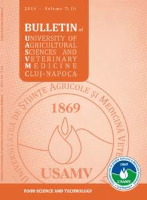
Bulletin of University of Agricultural Sciences and Veterinary Medicine Cluj-Napoca-Food Science and Technology
Exploring Innovations in Food Safety and QualityBulletin of University of Agricultural Sciences and Veterinary Medicine Cluj-Napoca - Food Science and Technology is a prominent peer-reviewed journal dedicated to advancing the field of food science and technology. Published by the University of Agricultural Sciences and Veterinary Medicine Cluj-Napoca, this open-access journal has been serving the academic community since 2013, promoting the dissemination of high-quality research that addresses pressing issues in food safety, quality, and innovation. With its ISSN 2344-2344 and E-ISSN 2344-5300, the journal aims to bridge the gap between academia and industry by providing a platform for scholars and practitioners to share their findings, insights, and methodologies. Situated in the heart of Romania, the journal reflects the country's rich agricultural heritage and its commitment to enhancing global food systems. By maintaining a rigorous editorial standard, the Bulletin ensures that it remains a vital resource for researchers, industry professionals, and students who are keen to explore the latest developments in food science.
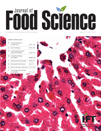
JOURNAL OF FOOD SCIENCE
Bridging Research and Application in Food ScienceJOURNAL OF FOOD SCIENCE, published by Wiley, is a premier journal dedicated to advancing the field of food science, bridging the gap between fundamental research and practical application. With an impressive impact factor reflecting its authoritative status, the journal is ranked in the Q1 quartile for Food Science in 2023 and boasts a Scopus ranking of #71 out of 389, placing it in the 81st percentile within Agricultural and Biological Sciences. First launched in 1936, the journal continues to serve as an essential platform for researchers, professionals, and students to disseminate innovative studies and reviews that address critical issues in food quality, safety, and technology. While not currently offering open access, its rigorous peer-review process ensures the dissemination of high-quality and impactful research. Researchers engaged in the vital disciplines of food science will find this journal indispensable for keeping abreast of cutting-edge developments in the field.

Food Frontiers
Innovating Food Production for Tomorrow's NeedsFood Frontiers, an esteemed publication in the Food Science domain, is proudly published by WILEY. Launched as an Open Access journal in 2020, it aims to facilitate the dissemination of high-quality research that influences contemporary food science and technology. The journal, with an E-ISSN of 2643-8429, has rapidly ascended to a Category Quartile ranking of Q1 in the Food Science category as of 2023, and boasts an impressive Scopus rank of #31 out of 389 in Agricultural and Biological Sciences, placing it in the 92nd percentile. The journal's mission is to explore innovative approaches to food production, safety, and sustainability, making it an essential resource for researchers, industry professionals, and students eager to stay at the forefront of food science advancements. With a commitment to open accessibility, Food Frontiers fosters collaboration and knowledge sharing across the globe, addressing the critical challenges and trends in feeding the world sustainably.

PHYTOCHEMICAL ANALYSIS
Pioneering Analytical Methods for Phytochemical DiscoveryPHYTOCHEMICAL ANALYSIS is a renowned journal published by WILEY that serves as a vital resource in the fields of analytical chemistry, biochemistry, and plant sciences, among others. With an ISSN of 0958-0344 and an E-ISSN of 1099-1565, this journal has been at the forefront of phytochemical research since its inception in 1990, with a commitment to advancing knowledge up to 2024. Notably, it boasts impressive Scopus rankings, including a Q1 quartile in Complementary and Alternative Medicine, highlighting its significant impact in this area. The journal provides essential insights into phytochemical analysis for a diverse audience that includes researchers, industry professionals, and students, thereby facilitating the discovery and application of phytochemicals in various fields such as drug discovery and food science. The journal is not currently open access, yet it remains a pivotal platform for disseminating high-quality research findings. With its focus on interdisciplinary approaches and innovative methodologies, PHYTOCHEMICAL ANALYSIS continues to reinforce its reputation as a cornerstone of contemporary research in plant science and related disciplines.
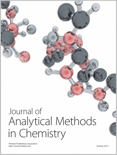
Journal of Analytical Methods in Chemistry
Connecting theory and practice for a brighter scientific future.The Journal of Analytical Methods in Chemistry, published by HINDAWI LTD, stands as a premier platform dedicated to the dissemination of research in the vibrant field of analytical chemistry. With an ISSN of 2090-8865 and an E-ISSN of 2090-8873, this Open Access journal has been committed to providing unrestricted access to quality research since 1978, thereby fostering greater collaboration and innovation among researchers, professionals, and students globally. The journal showcases rigorous research insights spanning diverse categories, earning impressive Scopus rankings including Q2 in Chemical Engineering and Q3 in Analytical Chemistry for 2023, positioning itself effectively among respected peers. Its interdisciplinary approach also covers significant contributions in the realms of instrumentation and computer science applications, thus addressing contemporary challenges and advancements in analytical methodologies. By bridging theoretical underpinnings with practical applications, the Journal of Analytical Methods in Chemistry aims to catalyze knowledge exchange while enhancing the global discourse in analytical science.
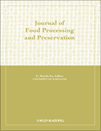
JOURNAL OF FOOD PROCESSING AND PRESERVATION
Exploring Cutting-edge Solutions for Global Food SafetyJOURNAL OF FOOD PROCESSING AND PRESERVATION, published by Wiley-Hindawi, stands as a vital resource within the fields of Food Science, Chemical Engineering, and Chemistry. With an ISSN of 0145-8892 and an E-ISSN of 1745-4549, the journal has been a beacon of knowledge since its inception in 1977, continuing to provide valuable insights to the research community until 2024. Recognized for its quality, it holds a noteworthy Q2 ranking in 2023 across multiple categories, including Food Science and Chemical Engineering, indicating its influential contribution to the academic discourse. Although it offers no open access, the journal remains a crucial platform for disseminating groundbreaking research and innovative methodologies in food processing and preservation. Researchers, professionals, and students can significantly benefit from its comprehensive reviews, original research articles, and case studies, aimed at advancing knowledge and practices in food technology. By bridging the gap between theoretical advancements and practical applications, the JOURNAL OF FOOD PROCESSING AND PRESERVATION plays an essential role in addressing global food safety, sustainability, and quality challenges.

LWT-FOOD SCIENCE AND TECHNOLOGY
Exploring the science behind food quality.LWT - Food Science and Technology is a premier academic journal published by Elsevier, specializing in the multifaceted fields of food science and technology. With a distinguished presence since its inception in 1973, this journal has evolved to become a vital resource for researchers and professionals aiming to advance knowledge in food safety, preservation, processing, and sensory analysis. Currently ranked in the Q1 quartile of food science journals, it holds an impressive Scopus ranking of 22 out of 389 in the Agricultural and Biological Sciences category, placing it in the 94th percentile. While certain articles may be available via subscription, LWT is committed to disseminating cutting-edge research that enhances food quality and innovation. This journal not only serves as a critical platform for the exchange of scientific ideas but also addresses contemporary challenges in food technology, ensuring that it remains essential for scholars, industry professionals, and students alike seeking to contribute to and stay abreast of advancements in the field.
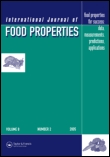
INTERNATIONAL JOURNAL OF FOOD PROPERTIES
Uncovering the science behind what we eat.INTERNATIONAL JOURNAL OF FOOD PROPERTIES, published by TAYLOR & FRANCIS INC, is a leading platform for disseminating high-quality research in the field of food science. With an ISSN of 1094-2912 and E-ISSN of 1532-2386, this journal has been committed to open access since 2018, ensuring that groundbreaking studies are readily available to global audiences. The journal has steadily gained recognition for its contribution to the discipline, achieving a Q2 ranking in Food Science and placing in the 68th percentile among its peers according to Scopus metrics. Covering a wide array of topics related to the properties and applications of food, it serves as a valuable resource for researchers, professionals, and students alike. With coverage extending from 1998 to 2024, the journal continually seeks to advance knowledge and foster innovation within the food science community, making it a pivotal publication for anyone serious about this vital field.

FOOD AND AGRICULTURAL IMMUNOLOGY
Innovating Agricultural Science Through Immunological ResearchFOOD AND AGRICULTURAL IMMUNOLOGY, published by Taylor & Francis Ltd, is a distinguished journal dedicated to the intersection of immunology and agricultural sciences, providing valuable insights in areas such as food safety, plant health, and disease resistance since its inception in 1989. Operating as an Open Access journal since 2017, it offers researchers and professionals unrestricted access to groundbreaking studies and reviews that advance the understanding of immunological responses in agricultural contexts. With its current quartile rankings of Q2 in Agronomy and Crop Science and Q3 in Food Science, as well as Q4 in Immunology, the journal has established itself as a vital resource for those aiming to enhance the quality and safety of food production through innovative research. By leveraging its impressive Scopus rankings across various categories, the journal promotes interdisciplinary collaboration and knowledge dissemination pertinent to both scientists and policymakers engaged in the agricultural and food sectors.

Food Biophysics
Advancing Insights into Food's Biophysical PropertiesWelcome to Food Biophysics, an esteemed journal published by SPRINGER, dedicated to advancing the field of food science through the lens of biophysics. With an ISSN of 1557-1858 and an E-ISSN of 1557-1866, this journal provides a platform for the dissemination of innovative research from 2006 to 2024. Food Biophysics holds a distinguished position in the academic community, boasting a Q1 ranking in Food Science and Q2 rankings in Analytical Chemistry, Applied Microbiology and Biotechnology, Bioengineering, and Biophysics. This positions the journal in the 73rd percentile for Food Science, signifying its relevance and influence in the field. Although not Open Access, it remains an invaluable resource for researchers, professionals, and students interested in the intricate biophysical properties of food materials and processes. Explore cutting-edge findings that bridge disciplines and advance our understanding of how biophysics can innovate food preservation, safety, and quality.